Walvisteuthis jeremiahi
Michael Vecchione and Richard E. YoungIntroduction
Walvisteuthis jeremiahi is the most recent species to be described in this genus. All members of the genus are very similar and difficult to tell apart. They are all short and plump with no trace of a tail. W. jeremiahi is distinguished from its close relative W. rancureli by statistical differences in counts and measurments (comparison of species is found on the Walvisteuthis page).
Brief diagnosis:
A Walvisteuthis with:
- Club hooks with broad, deep curve.
- 14-22.1-25 (range, bold = mean) hooks on tentacular club.
- 6-7.1-9 (range, bold = mean) carpal suckers on tentacular club.
Characteristics
- Arms
- Muscular. Arm formula: III≥IV>II>>I. Arms II-IV ~ 65% ML.
- Suckers biserial; sucker inner rings smooth.
- Arms I with 15-26-40 (range, bold = mean); arms II with 19-28-48 suckers; arms III with 17-28-48 suckers; arms IV with 16-31-48 suckers.
- Muscular. Arm formula: III≥IV>II>>I. Arms II-IV ~ 65% ML.
- Tentacles
- Clubs with 14-22.1-25 hooks; each hook sturdy and approximately bilaterally symmetrical.
- Club manus with 4-8 (total) marginal suckers.
- Terminal pad with 2-4 suckers.
- Carpus with 6-7.1-9 suckers and 5-9 knobs.
- Club length 28-40-59% ML.
 Click on an image to view larger version & data in a new window
Click on an image to view larger version & data in a new window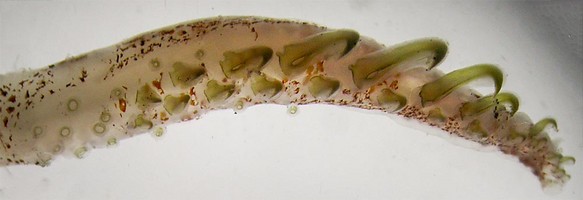

Figure. Tentacular clubs of the holotype of W. jeremiahi, male, 57 mm ML. Top - Oral view of the right club with distal tip damaged. Bottom - Ventral view of part of the left showing a near-profile view of the large hooks. Tips of two arms also visible. Photographs by M. Vecchione.
- Clubs with 14-22.1-25 hooks; each hook sturdy and approximately bilaterally symmetrical.
- Head
- Head width 26-36-53% ML
- Mantle
- Mantle smooth, muscular and stubby; width 33-41-53% ML.
- Fins
- Fins short (length 34-42-53% ML), broad (width 81-96-129%ML) and without any posterior medial extension (i.e., no tail).
- Photophores
- Photophores absent.
 Click on an image to view larger version & data in a new window
Click on an image to view larger version & data in a new window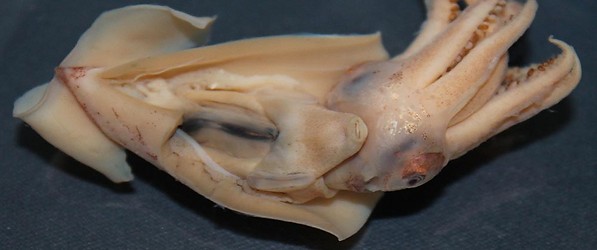
Figure. Ventral view of W. jeremiahi, paratype, male, 44 mm ML with mantle cavity exposed. Note the absence of visceral and ocular photophores. Also note the posterior termination of the mantle and fins without any trace of a "tail." Photograph by M. Vecchione ??
- Photophores absent.
- Gladius
- Gladius visible along dorsal midline and with typical Walvisteuthis shape. Maximum width ~28% GL; rostrum laterally flattened, triangular and directed dorsally.
- Gladius visible along dorsal midline and with typical Walvisteuthis shape. Maximum width ~28% GL; rostrum laterally flattened, triangular and directed dorsally.
- Table of counts and measurements (from Vecchione, et al., 2015).
Distribution
Type Locality - Gulf of Mexico at 27.8°N, 86.4°W.
Geographical Distribution - Presently known only from the Gulf of Mexico and Gulf Stream waters of the western North Atlantic.
References
Vecchione, M., Sosnowski, A. and Young, R. E. 2015. Walvisteuthis jeremiahi n. sp. (Mollusca: Cephalopoda), an onychoteuthid squid from the Gulf of Mexico. Proceedings of the Biological Society of Washington, 128(2): 164-175. doi:10.2988/0006-324X-128.2.164
Title Illustrations

| Scientific Name | Walvisteuthis jeremiahi |
|---|---|
| Location | Gulf of Mexico at 27.8°N, 86.4°W |
| Acknowledgements | Image modified from Vecchione et al., 2015 |
| Specimen Condition | Fresh |
| Identified By | Michael Vecchione |
| Sex | Male |
| View | Dorsal, ventral |
| Size | 57 mm ML |
| Collection | USNM 1179361 |
| Type | Holotype |
| Image Use |
 This media file is licensed under the Creative Commons Attribution-NonCommercial License - Version 3.0. This media file is licensed under the Creative Commons Attribution-NonCommercial License - Version 3.0.
|
| Copyright |
©

|
| Scientific Name | Walvisteuthis jeremiahi |
|---|---|
| Location | Gulf of Mexico at 27.8°N, 86.4°W |
| Comments | Scale bar is 10 mm. |
| Acknowledgements | Drawing from: Vecchione, M., Sosnowski, A. and Young, R. E. 2015. Walvisteuthis jeremiahi n. sp. (Mollusca: Cephalopoda), an onychoteuthid squid from the Gulf of Mexico. Proceedings of the Biological Society of Washington, 128(2): 164-175. doi:10.2988/0006-324X-128.2.164 |
| Sex | Male |
| View | Ventral |
| Size | 57 mm ML |
| Collection | USNM 1179361 |
| Type | Holotype |
| Image Use |
 This media file is licensed under the Creative Commons Attribution-NonCommercial License - Version 3.0. This media file is licensed under the Creative Commons Attribution-NonCommercial License - Version 3.0.
|
| Copyright | © Amanda Sosnowski |
About This Page

National Museum of Natural History, Washington, D. C. , USA

University of Hawaii, Honolulu, HI, USA
Correspondence regarding this page should be directed to Michael Vecchione at
Page copyright © 2015 and
 Page: Tree of Life
Walvisteuthis jeremiahi .
Authored by
Michael Vecchione and Richard E. Young.
The TEXT of this page is licensed under the
Creative Commons Attribution-NonCommercial License - Version 3.0. Note that images and other media
featured on this page are each governed by their own license, and they may or may not be available
for reuse. Click on an image or a media link to access the media data window, which provides the
relevant licensing information. For the general terms and conditions of ToL material reuse and
redistribution, please see the Tree of Life Copyright
Policies.
Page: Tree of Life
Walvisteuthis jeremiahi .
Authored by
Michael Vecchione and Richard E. Young.
The TEXT of this page is licensed under the
Creative Commons Attribution-NonCommercial License - Version 3.0. Note that images and other media
featured on this page are each governed by their own license, and they may or may not be available
for reuse. Click on an image or a media link to access the media data window, which provides the
relevant licensing information. For the general terms and conditions of ToL material reuse and
redistribution, please see the Tree of Life Copyright
Policies.
- First online 11 October 2015
- Content changed 11 October 2015
Citing this page:
Vecchione, Michael and Richard E. Young. 2015. Walvisteuthis jeremiahi . Version 11 October 2015 (temporary). http://tolweb.org/Walvisteuthis_jeremiahi/149639/2015.10.11 in The Tree of Life Web Project, http://tolweb.org/




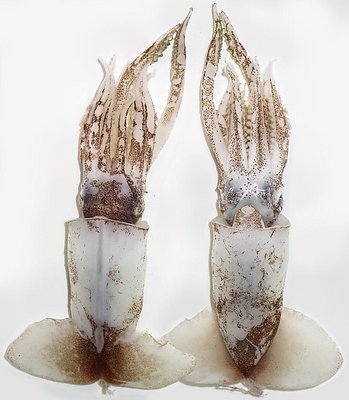
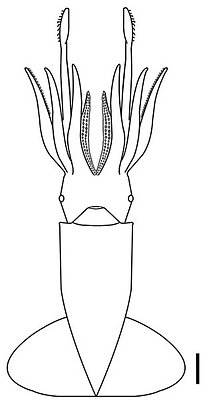

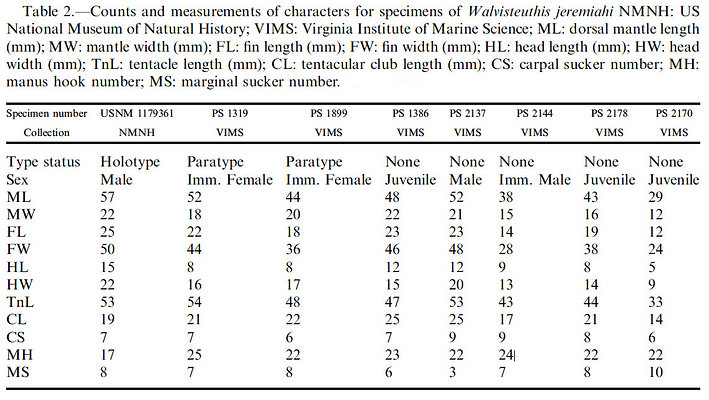




 Go to quick links
Go to quick search
Go to navigation for this section of the ToL site
Go to detailed links for the ToL site
Go to quick links
Go to quick search
Go to navigation for this section of the ToL site
Go to detailed links for the ToL site